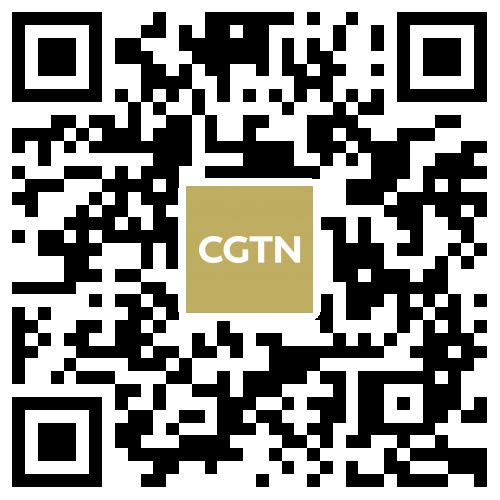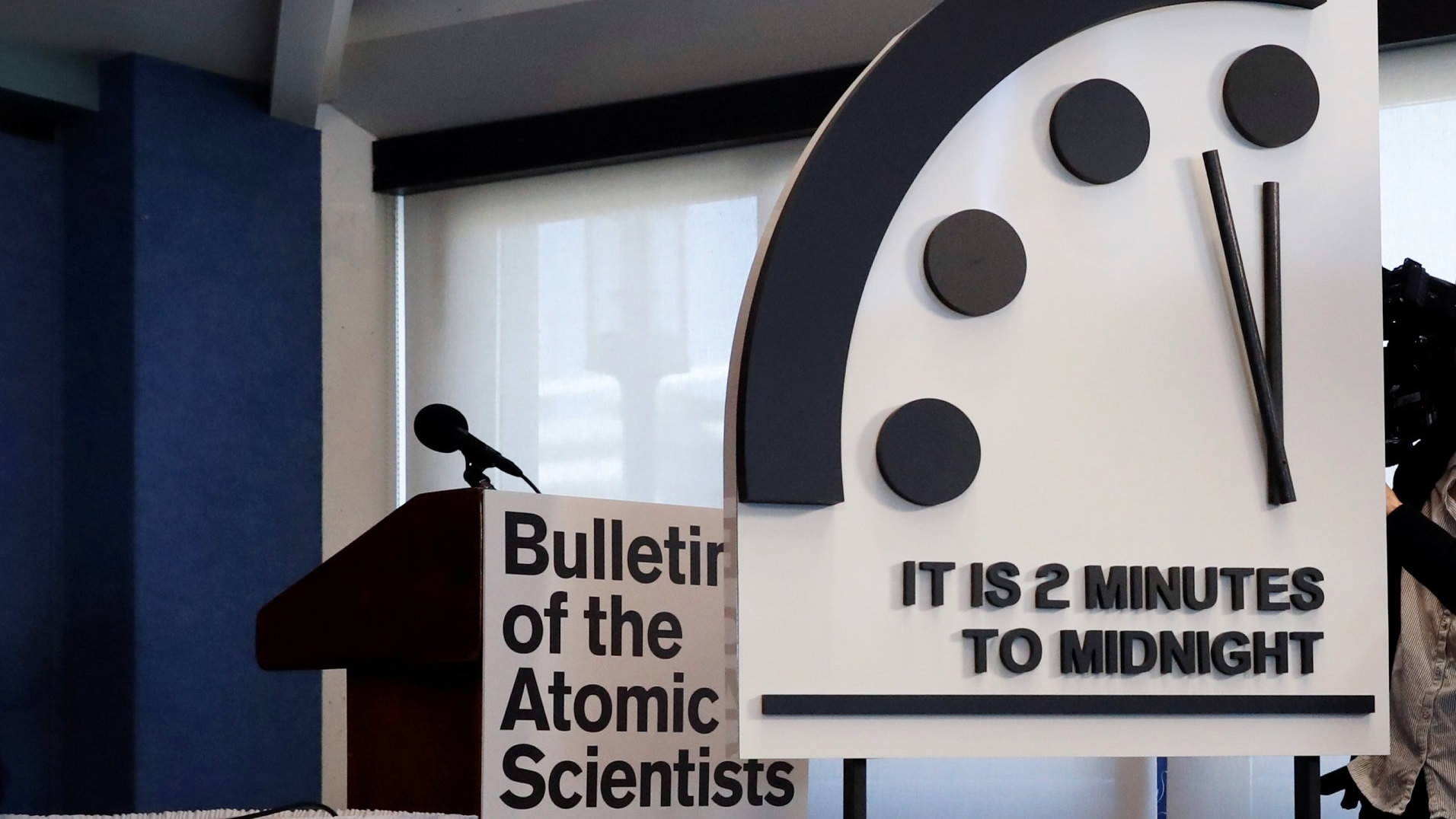The world is two minutes away from annihilation, US scientists announced on Thursday.
Obviously, they did not mean it literally: hours later, the planet has not been obliterated by atomic weapons and has not imploded under the pressures of climate change.
Still, with a US president and DPRK leader now literally comparing the size of their nuclear buttons and democratic institutions under siege, the world is closer to its untimely demise than at any time since the Cold War, according to the Doomsday Clock.
What is the Doomsday Clock?
The Clock is the imaginative way that a group of scientists came up with in 1947 to explain the risk of nuclear war. Since then, the Bulletin of Atomic Scientists, a US scientific journal, has updated its prediction every year. In this scenario, midnight represents the apocalypse.

A television screen showing a file video footage of a missile launch by the DPRK at a railway station in Seoul, November 29, 2017. /VCG Photo
A television screen showing a file video footage of a missile launch by the DPRK at a railway station in Seoul, November 29, 2017. /VCG Photo
In 1947, the Clock stood at seven minutes to midnight. This has fluctuated over the intervening seven decades, but the farthest the long hand ever stood from midnight was in 1991 after the fall of the Iron Curtain and the end of the Cold War: the Doomsday Clock that year gave the time as 11:43 p.m., or 17 minutes to midnight.
What time is it now?
The Bulletin dropped the bomb on Thursday night, Beijing time: it is now two minutes to midnight. This was 30 seconds closer than last year.
The only other time the long hand has stood this close to 12 was in 1953, following the US decision to build a hydrogen bomb and a prior thermonuclear test, as well as a Soviet H-bomb test.

The Doomsday Clock's new time is revealed during a
news conference in Washington, US, January 25, 2018. /Reuters Photo
The Doomsday Clock's new time is revealed during a
news conference in Washington, US, January 25, 2018. /Reuters Photo
Last year, the hand was moved to two and a half minutes to midnight, after spending two years at three minutes before the hour.
Is it only about nuclear war?
When the Clock was invented, the world had just witnessed the destruction caused by atomic weapons, so nuclear annihilation was the biggest existential threat on the horizon. But a number of other threats have emerged alongside it over the years.
Climate change, with its potential impact on sea levels, natural resources, species and communities, has emerged as the other main end-of-the-world threat.

Cloud-to-ground lightning is captured during a thunderstorm in Boise, Oklahoma, May 21, 2017. /VCG Photo
Cloud-to-ground lightning is captured during a thunderstorm in Boise, Oklahoma, May 21, 2017. /VCG Photo
But other smaller risks, from hacking to fake news, have also been taken into account more recently.
What are the causes of doom in 2018?
Nuclear threat
This continues to present the biggest risk to humanity, the Bulletin said Thursday.
It cited nuclear and missile tests by the DPRK last year, as well as “hyperbolic rhetoric and provocative actions” by Pyongyang and Washington that “have increased the possibility of nuclear war by accident or miscalculation.”
Trump and Kim have embarked on a war of words in recent months, comparing the size of the nuclear buttons on their desks and threatening each other with “fire and fury.”

This undated picture released by the official Korean Central News Agency (KCNA) on December 9, 2017 shows DPRK leader Kim Jong Un visiting Mount Paektu in Ryanggang Province. /VCG Photo
This undated picture released by the official Korean Central News Agency (KCNA) on December 9, 2017 shows DPRK leader Kim Jong Un visiting Mount Paektu in Ryanggang Province. /VCG Photo
Increasingly conflictual relations between the US and Russia, tensions in the Asia-Pacific region, a nuclear build-up in South Asia and uncertainty over a crucial 2015 Iran nuclear deal have contributed to the bleak picture.
Climate change
Natural disasters last year, from hurricanes that devastated the Caribbean, to forest fires that tore through the US and extreme heat waves in Europe, Latin America and Asia, proved that climate change was really happening. Yet “climate denialists”, including at the top levels of the US government, continued to pursue policies that harmed the environment, the Bulletin's scientists deplored on Thursday.
Information technology
This has become one of the biggest threats to democracy. Over the past two years, hacking and disinformation campaigns have sought to influence elections and have fueled mistrust in facts, science and the media.

This file photo taken on November 20, 2017 shows logos of social networking service Facebook. /VCG Photo
This file photo taken on November 20, 2017 shows logos of social networking service Facebook. /VCG Photo
“Technological change is disrupting democracies around the world as states seek and exploit opportunities to use information technologies as weapons,” the Bulletin warned.
It also took a swipe at the bosses of social media and Internet firms like Facebook and Google for failing to act quickly and stop their platforms from being misused.
The United States
While the Bulletin did not explicitly cite Washington as a cause of doom and gloom, many of its listed threats tied back to actions from the Trump administration, such as the president’s opposition to the Iran nuclear deal, and his decision to pull out of the 2016 Paris Agreement on Climate Change.
The apparently never-ending chaos and confusion at the White House has also created uncertainty among allies looking for US support and clarity.

US President Donald Trump speaks during a national security strategy speech at the Ronald Reagan Building in Washington, DC, US, December 18, 2017. /VCG Photo
US President Donald Trump speaks during a national security strategy speech at the Ronald Reagan Building in Washington, DC, US, December 18, 2017. /VCG Photo
These “have been forced to negotiate a thicket of conflicting policy statements from a US administration … led by an undisciplined and disruptive president, and unable to develop, coordinate, and clearly communicate a coherent nuclear policy,” the Bulletin said.
Who are the people behind it?
Whether or not the Clock needs to be adjusted is decided every year by the Bulletin’s science and security board – experts in threat assessment, nuclear security, climate science or cyber security – and its board of sponsors. The latter includes 15 Nobel Prize laureates and names like Stephen Hawking and Skype co-founder Jaan Tallinn. Past members include Albert Einstein and Robert Oppenheimer.
The Bulletin was created in 1945 by scientists from the Manhattan Project, the US atomic weapons program.








